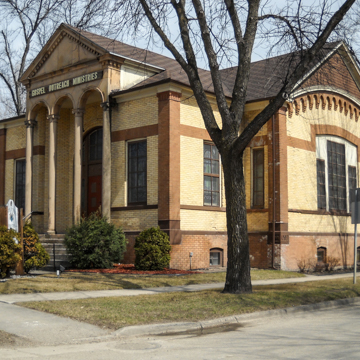You are here
Gospel Outreach Ministries (First Church of Christ Scientist)
Within two blocks’ walking distance of United Lutheran Church (GF16) and B’nai Israel Synagogue (GF17), the First Church of Christ Scientist represents an earlier eclectic classical design tradition. This was reportedly the first Christian Science church erected in North Dakota. An impressive glass dome that originally capped the intersecting gables was removed, probably around 1936 in the course of renovations. Tall and slender Ionic columns support the central portico and the Ionic motif is repeated for the sandstone capitals on the corner pilasters. Two-colored brickwork with corner pilasters and a blind arcade embellishes the gabled ends that have scalloped shingles above. Impressive stained glass windows are visible behind the small panes of outer sash. It would be difficult to place this design within the work of any of Grand Forks’ better-known architects. The design was likely influenced by a standardized model design recommended by Mary Baker Eddy’s New England–based Mother Church. This building differs markedly from the more traditionally classical First Church of Christ Scientist (CS23) in Fargo.
Writing Credits
If SAH Archipedia has been useful to you, please consider supporting it.
SAH Archipedia tells the story of the United States through its buildings, landscapes, and cities. This freely available resource empowers the public with authoritative knowledge that deepens their understanding and appreciation of the built environment. But the Society of Architectural Historians, which created SAH Archipedia with University of Virginia Press, needs your support to maintain the high-caliber research, writing, photography, cartography, editing, design, and programming that make SAH Archipedia a trusted online resource available to all who value the history of place, heritage tourism, and learning.















